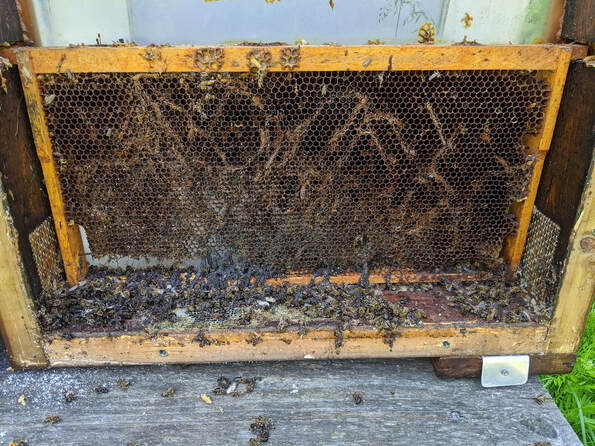 Achroia grisella (The Lesser Wax Moth) As I’ve said before, wax or comb is an invaluable source for a beekeeper. One of the challenges that faces a beekeeper is how to store this precious resource in order to preserve it for use in future hives. Two factors to consider for frame storage are moisture which can cause frames to mold and most importantly wax moths. As hive beetle larvae can destroy improperly stored frames of honey, wax moths and their larvae can destroy all frames containing comb, though they show a preference for older, darker comb that has contained brood. Best There are two ways to store comb that are more successful and full-proof ways to prevent wax moth damage. The best way to store wax frames is in a freezer. This not only kills wax moth eggs that are present in all comb that has been inside a hive for any length of time, but will also protect the comb from pests such as mice and from mold. Unfortunately, most beekeepers do not possess large enough freezers to hold all of their excess comb. In this case, the second-best method of storage is to stack boxes of frames such that they are protected from pests (i.e. with a telescoping outer cover on the bottom and top of the stack), and to apply moth crystals (or Para-Moth, NOT MOTH BALLS) according to the label. Crisscross The two easiest ways to store frames of wax do not require a freezer or the purchase of chemical treatments, but are sometimes not as successful. The first is to store the boxes containing the frames in an open-air structure (for ventilation), on their sides (so that sunlight and air flow may penetrate between the frames), and in a crisscross pattern (with each box facing ninety degrees to the one above and below). Wax moths do not like light or the flow of air, so this storage will help deter them, though may not work for frames containing darker brood comb. The final way to store frames is to place the boxes of comb on strong hives that will be able to patrol the comb and keep the frames free of wax moths. With this final method, a beekeeper should check the storage hives about every week or so to make sure they are still strong and that wax moths have not moved into the frames of the stored boxes. More Information: https://www.honeybeesuite.com/how-and-where-should-i-store-empty-supers/ https://glorybee.com/blog/top-3-ways-to-prevent-wax-moths/
1 Comment
 Amazing Honey has many amazing properties. At the proper water content, honey that has been properly stored will never expire or go bad. In fact, honey that has been recovered from Egyptian tombs and is over 2,000 years old is still edible. One of the reasons for this longevity is that honey is antimicrobial, meaning that organisms such as bacteria and fungi do not live and grow in honey (the one exception to this is botulism spores). Three factors that make honey antimicrobial are 1) the fact that it is slightly acidic, 2) that it is a supersaturated solution, and 3) that it contains compounds such as hydrogen peroxide. Honey has been used for thousands of years medicinally to aid in wound and burn healing. Blend Bees make honey during the spring, summer, and fall, but typically only consume it during the winter and early spring, preferring to consume fresh nectar and pollen in the form of bee bread (pollen mixed with nectar or honey) during the honey flow. Honey can be thought of as nectar that has been processed for long term storage. Unlike when bees store the pollen from multiple species of flowers in the same cell, bees only store nectar from the same species of flower in the same cell. Also, honey bees typically store all the nectar obtained from a single floral source in the same area of the hive or same frame. This results in different colors of honey depending on the floral source and different varieties of honey (ex. clover honey vs orange blossom honey). Crop Though I think it’s funny to think of honey as bee vomit, honey is actually the substance produced by bees when regurgitated nectar from their crop (or honey stomach) is exposed to the enzyme invertase produced by the bee’s salivary gland which converts the sugar sucrose from nectar into glucose and fructose. The liquid honey which is now made up of glucose and fructose is stored in the wax cells of the hive and dehydrated by the bees until its water content is at or below 18.6%, at which point the wax cells are capped. More Information: https://honey.com/about-honey/how-honey-is-made |
AuthorJen Haeger is a new master beekeeper and board member of A2B2. Archives
August 2022
Categories
All
|


 RSS Feed
RSS Feed
